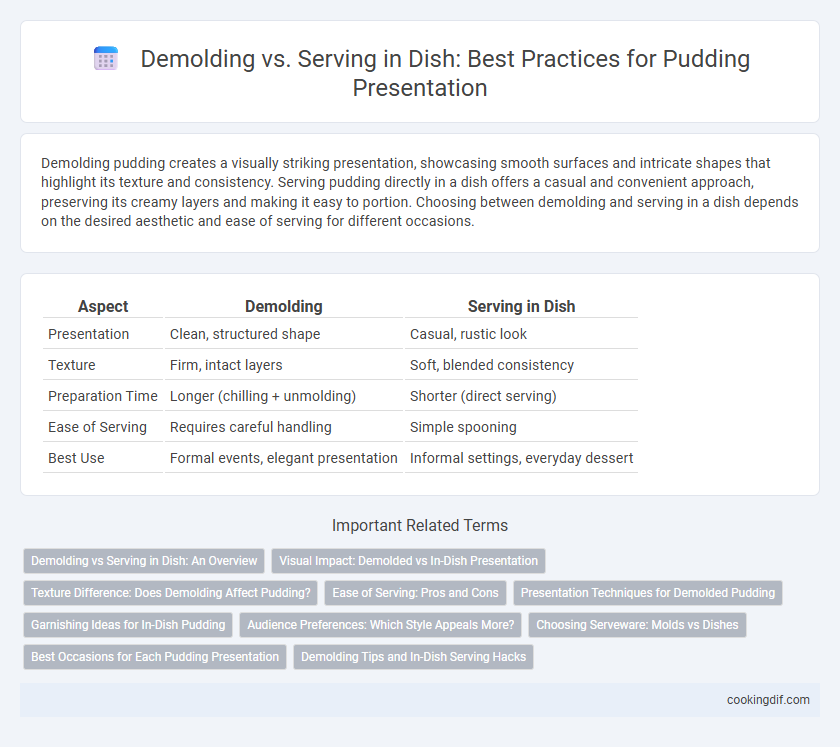Demolding pudding creates a visually striking presentation, showcasing smooth surfaces and intricate shapes that highlight its texture and consistency. Serving pudding directly in a dish offers a casual and convenient approach, preserving its creamy layers and making it easy to portion. Choosing between demolding and serving in a dish depends on the desired aesthetic and ease of serving for different occasions.
Table of Comparison
| Aspect | Demolding | Serving in Dish |
|---|---|---|
| Presentation | Clean, structured shape | Casual, rustic look |
| Texture | Firm, intact layers | Soft, blended consistency |
| Preparation Time | Longer (chilling + unmolding) | Shorter (direct serving) |
| Ease of Serving | Requires careful handling | Simple spooning |
| Best Use | Formal events, elegant presentation | Informal settings, everyday dessert |
Demolding vs Serving in Dish: An Overview
Demolding pudding involves carefully inverting the set dessert onto a plate to showcase its smooth, decorative surface and maintain its shape, enhancing visual appeal for formal presentation. Serving pudding directly in a dish simplifies the process, preserving the dessert's texture and preventing potential damage during transfer, making it ideal for casual settings. Both methods influence the pudding's texture perception and presentation style, with demolding emphasizing elegance and serving in a dish prioritizing convenience.
Visual Impact: Demolded vs In-Dish Presentation
Demolding pudding reveals a smooth, defined shape that enhances its visual appeal, often highlighting intricate mold patterns and creating a striking centerpiece. Serving pudding directly in the dish maintains a rustic, casual look but can result in a less polished presentation with uneven edges. The choice between demolding and in-dish serving significantly influences the dessert's perceived elegance and visual impact on the table.
Texture Difference: Does Demolding Affect Pudding?
Demolding pudding enhances its appearance with a smooth, firm surface, but can slightly alter texture by reducing moisture on the exterior, resulting in a denser bite. Serving pudding directly in the dish preserves a creamier, softer consistency, maintaining the original silky texture. The choice between demolding and serving in the dish ultimately influences the tactile experience and visual appeal of the pudding.
Ease of Serving: Pros and Cons
Demolding pudding creates a visually striking presentation with clean edges but can risk sticking or breaking, requiring careful preparation and timing. Serving directly in the dish offers effortless portioning and minimal handling, preserving the pudding's delicate texture but may lack the polished appearance of a molded dessert. Choosing between the two methods depends on balancing presentation style with ease and consistency of serving.
Presentation Techniques for Demolded Pudding
Demolding pudding flawlessly involves gently loosening the edges with a thin knife and briefly warming the mold in warm water to ensure smooth release, preserving the pudding's shape and texture. For enhanced presentation, carefully invert the pudding onto a chilled serving plate, allowing it to retain its glossy surface and intricate details. Garnishing with fresh fruits, edible flowers, or a drizzle of complementary sauce accentuates the pudding's visual appeal, creating an elegant dessert focal point.
Garnishing Ideas for In-Dish Pudding
In-dish pudding presents unique opportunities for garnishing that enhance both visual appeal and texture without the risk of damaging the dessert during demolding. Fresh berries, edible flowers, and a dusting of powdered sugar create vibrant contrasts against creamy puddings, while swirls of caramel or chocolate sauce add depth and elegance. Sprinkling crushed nuts or toasted coconut introduces a delightful crunch, elevating the overall sensory experience directly in the serving dish.
Audience Preferences: Which Style Appeals More?
Demolding pudding creates a polished, elegant presentation that appeals to audiences seeking sophistication and visual impact. Serving pudding directly in a dish offers a rustic, homemade charm favored by those valuing comfort and simplicity. Audience preferences vary based on occasion and personal taste, with formal events leaning towards demolded styles, while casual gatherings often embrace the dish-served approach.
Choosing Serveware: Molds vs Dishes
Choosing serveware for pudding presentation significantly impacts its visual appeal and texture retention; molds provide structured shapes that enhance aesthetic precision, while dishes offer a rustic, casual look that emphasizes creaminess and ease of serving. When using molds, ensure they are lightly greased or lined with plastic wrap to facilitate smooth demolding without compromising the pudding's form. Serving directly in dishes eliminates the risk of breaking, ideal for softer puddings like custards or mousses where presentation highlights texture rather than shape.
Best Occasions for Each Pudding Presentation
Demolding pudding creates an elegant, smooth shape ideal for formal events like dinner parties or holiday gatherings where visual appeal enhances the dining experience. Serving pudding directly in its dish suits casual occasions such as family breakfasts or potlucks, emphasizing convenience and comfort. Choosing the presentation style depends on the event's atmosphere, balancing aesthetics with ease of serving.
Demolding Tips and In-Dish Serving Hacks
Demolding pudding requires careful greasing of the mold with butter or oil and brief immersion in warm water to loosen the edges for a smooth release. Using a silicone mold or lining the dish with plastic wrap can facilitate easy demolding and maintain the pudding's shape. For in-dish serving, layering puddings with toppings or garnishes directly in the dish enhances presentation while eliminating the risk of breakage during unmolding.
Demolding vs Serving in dish for presentation Infographic

 cookingdif.com
cookingdif.com